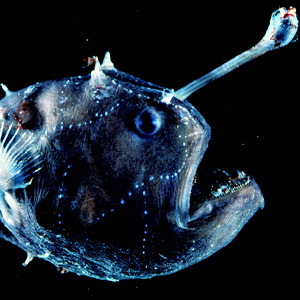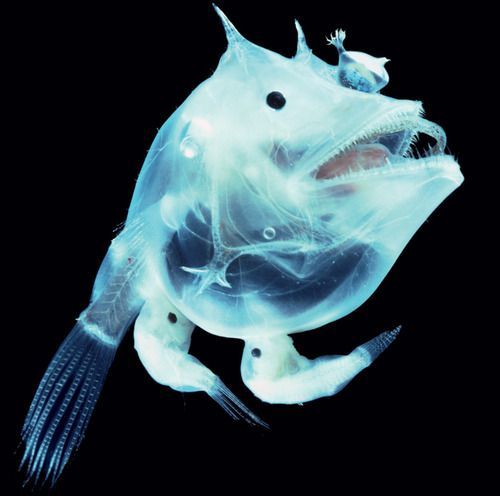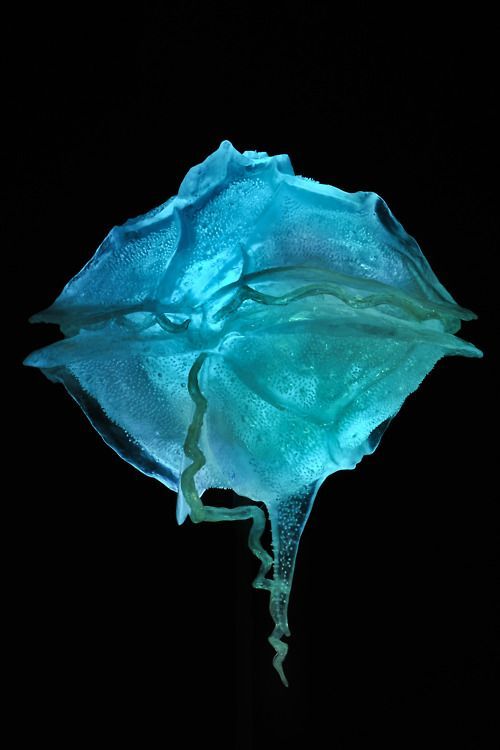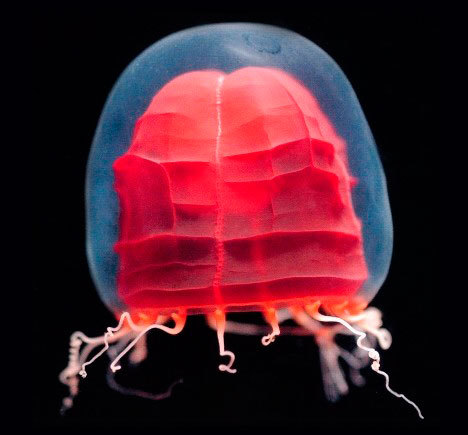Ocean Ecosystem - Blog Posts

Glasshead Grenadier
Hymenocephalus italicus
The Glasshead Grenadier is a small deep sea fish named due to a transparent memberane that covers its head. It has fragile head bones, and it feeds on surface copepods and crustaceans. This fish is located between 100 m to 2000 m in the ocean.
Photo credit: https://www.fishbase.se/summary/1720
https://www.futura-sciences.com/planete/photos/oceanographie-abysses-ces-merveilles-profondeurs-40-photos-686/ocean-grenadier-vitrier-hymenocephalus-italicus-poisson-abysses-4541/


Football Fish
Himantolophus paucifilosus
The Football fish is a deep sea angular fish located between 1000 to 4000 meters in the ocean. The glowing dots on its body are sensory organs called neuromast that help the fish detect changes in the water.
Photo credit: https://alchetron.com/Footballfish
https://www.amazon.com/Creatures-Deep-Search-Monsters-World/dp/1770852816


Deep-sea white anglerfish
Haplophryne mollis
The Deep-sea white anglerfish is a ghostly white creature found at depths between 1000m to 4000m. The strange bulge between its eyes is a bioluminescent lure. The main fish above is a female and the tiny fish attached to her body are males. Since it is difficult to find mates in the deep ocean, male fish latch onto the female with hooked teeth. Even though the male fish are parasitic, they are eventually reduced to pockets of sperm that are used for reproduction. For all you fellas out there that have a rough time with the ladies, be thankful that you are at least not a bag of gonads floating through the ocean.
Photo credit: https://www.pinterest.co.uk/pin/440297301041956897/
https://news.cgtn.com/news/3d3d414d3559444f7a457a6333566d54/share_p.html

Pram Bug
Phronima sedentaria
The Pram Bug is a deep sea amphipod that is located between 200 to 1000m in the ocean. It has a translucent exoskeleton and can see primarily blue light. It is also is contained in a hollowed out barrel that is used for protection and to house babies. The image above is a female pram bug carrying its young.
Photo Credit:https://ocean.si.edu/ocean-life/invertebrates/phronima-female-and-young

Periphyllopsis braueri
The Periphyllopsis braueri is a tiny, deep sea jellyfish that is only 6 cm in diameter. It is red-chocolate in color, and it has eight gonads. Furthermore, it is found at depths between 600m to 1000m.
Photo credit: https://oceanexplorer.noaa.gov/explorations/19gulfofalaska/logs/aug2/aug2.html


Pyrodinium bahamense
Pyrodinium bahamense is a tropical species of dinoflagellates that is found primarily in Atlantic Ocean waters. It prefers salinity around 20 psu and blooms when there are large amounts of nitrogen in the water. The dinoflagellate glows bright blue when agitated by motion. Furthermore, even though this plankton species is beautiful to look at, it causes seafood toxicity.
Photo credit: https://alchetron.com/Pyrodinium-bahamense
https://wonderchews.com/bodies-of-light/


Sea elephant
Carinaria japonica
The Sea Elephant is a translucent sea snail that has a large muscular body and a tiny triangular shell. Its foot is used for crawling on the ground, and it can be transformed into a fin that is used for swimming. It is called the “sea elephant” because it has a small trunk in its mouth that is used to swallow prey. Furthermore, the Sea Elephant eats arrow worms and jellies.
Photo credit
https://bodegahead.blogspot.com/2014/12/carinaria-part-2.html
http://tolweb.org/Carinaria_japonica/28750


Deep Sea Arrow Worm
Eukrohnia hamata
Arrow worms are small, predatory marine worms that consume copepods, ostracods, and larvae. They resembles a clear, ink pen whizzing through the dark sea. Furthermore, they are found primarily in the Artic Ocean between 700m to 1200m. The picture on the bottom is its head. They have 8 hooks, which are used to grab prey and 25 posterior teeth. Even though the arrow worms are terrifying up close, they are only 4.5 cm in size.
Photo credit: http://www.arcodiv.org/watercolumn/chaetognaths/Eukrohnia_hamata.html

Crystal Jellyfish
Aequorea victoria
The Crystal Jellyfish is a graceful, transparent jellyfish with long, thin tentacles. It has bioluminescent organs around it bell that produce a bright, green light. It tends to consume small copepods, but it has the ability to swallow other jellyfish half its size. Furthermore, this jelly is used in biological experiments to detect calcium.
Photo credit: https://www.montereybayaquarium.org/animals/animals-a-to-z/crystal-jelly
https://fineartamerica.com/featured/5-aequorea-crystal-jellyfish-with-amphipods-alexander-semenovscience-photo-library.html


Physonect Siphonophore
Nanomia cara
The Physonect siphonophore has tiny, bubble shaped sacs that are filled with gas. The sacs are called pneumatophores and help this creature move through the deep ocean. It also has venomous tentacles that stun prey and over eighty stomachs. There are numerous amounts of these strange creatures along the east coast, and they have cause some fisheries to collapse. Furthermore, they can be found at depth between 400m to 1000m.
Photo credit: http://www.seawater.no/fauna/cnidaria/cara.html
https://www.mindenpictures.com/stock-photo-siphonophore-hydrozoan-cnidarian-nanomia-cara-atlantic-nectophores-naturephotography-image90194961.html


Sea Gooseberry
Pleurobrachia pileus
The Sea Gooseberry is a comb jelly or ctenophore that has two enormous tentacles covered with adhesive cells. When tiny crustaceans, eggs, and larvae brush against the tentacles, the prey are stuck to them. The Sea Gooseberry draws the tentacles to its mouth, and it consumes the prey. These unique organisms can be found as deep as 750 m.



Black Dragonfish
Idiacanthus atlanticus
The Black Dragonfish are needle-like fish that migrate between 500m and 2000m in the deep ocean. Females are black with 6 stripes and lack a barbel, pelvic fins, and sharp teeth. Males, on the other hand, are dark brown and have a barbel, which is the light producing structure on its chin. Furthermore, it uses bioluminescence to detect prey instead of lure prey.
Photo credit: https://scitechdaily.com/scientists-learn-secrets-from-ultra-black-skin-that-allows-deep-sea-fish-to-lurk-unseen/
https://steemit.com/life/@munnashah/the-most-terrible-and-surprising-7-animals-of-the-sea
https://knowyourmeme.com/photos/995601-thalassophobia


Wolftrap Angler
Thaumatichthys binghami
The Wolftrap Angler is slightly different from many other species of anglers. It has its bioluminescent lure located inside of its mouth instead of connected to its body. Even though it is intimidating up close, it is only nine centimeters in size. It is found in the deep ocean at 2432m.
Photo credit
https://en.wikipedia.org/wiki/Thaumatichthys_binghami
https://igniteyourcuriosity.wordpress.com/2016/10/22/anglerfish/


Silky Medusa
Colobonema sericeum
The Silky Medusa is a gentle and reserved jellyfish; it has white-tipped tentacles that have the ability to detach from its body and bioluminescence when attacked by predators. It can be found drifting between 500 m to 1500 m. Furthermore, it consumes small crustaceans.
Photo credit: https://twitter.com/mbari_news/status/949736123760340994
https://www.montereybayaquarium.org/animals/animals-a-to-z/midwater-jelly


Cigar Comb Jelly
beroe forskalii
The Cigar Comb Jelly is a gelatinous ctenophore that is marveled by many due to its sparkling bioluminescence. It tends to elegantly float around 120 m in the ocean. It uses unique, hair-like structures called ctens to move horizontally in the ocean. It also swims in a spiral pattern before consuming zooplankton in the ocean.
Photo credit: https://www.wrobelphoto.com/gelatinouszooplankton/h25347306
https://www.flickr.com/photos/a_migotto/27227530815


Lav Polyp
leuckartiara octona
The Lav Polypo is a jelly that comes in a variety of colors and shapes; it dwells about 200m in the deep ocean. The red mass inside its translucent bell is the jelly’s reproductive organs. Furthermore, it uses its dull, yellow tentacles can catch unsuspecting prey.
Photo credit: https://www.pinterest.com/pin/65935582019848580/
https://www.petjellyfish.co.uk/shop/live-jellyfish/leuckartiara-octona


Red Paper Lantern Medusa
Pandea rubra
The Red Paper Lantern resembles a floating, Japanese paper lantern in the deep sea. It has the ability to crumple and wrinkle its bright, red bell, and it is located at depths between 550m to 1200m. It has also been nicknamed the “origami jelly.”
Photo credit: https://commons.wikimedia.org/wiki/Category:Pandea_rubra
http://www.thegorgeousdaily.com/pandea-rubra/

Black Medusa
Vampyrocrossota childressi
The Black Medusa is an inky, black hydrozoan that absorbs all light that hits its tiny body. It has a translucent gelatin and a black umbrella; it is also only 1.5 cm in size. Moreover, it is found at depths between 600m to 1500m, and it spends its entire life floating in the deep ocean.
Photo credit: https://www.pinterest.com/pin/488148047080475827/



Fangtooth
Anoplogaster cornuta
The Fangtooth is a ferocious predator that is found at depths between 600 m to 5000 m. It has large, needle like teeth that are used to catch prey. It also has extremely sensitive sensory canals underneath of its scales used to detect movement in the water. Furthermore, their preferred prey are crustaceans and fish.
Photo credit: https://pixels.com/featured/fangtooth-fish-dant-fenolio.html
https://www.pinterest.com/pin/845902742487789950/
https://www.newscientist.com/article/mg23231020-400-up-close-with-the-giant-teeth-of-the-deepsea-fangtooth/


Pigbutt worm
Chaetopterus pugaporcinus
The Pigbutt worm or the flying buttocks of the sea is spotted floating between 965 m to 1300 m in the deep ocean. It is actually a polychaete (polly-keet) worm species that burrows in the ground as an adult, and floats around the ocean as a baby. The worm feeds itself : by creating a balloon of mucus; collecting particles on the mucus; and then consuming the particles. It is the rarest and thickest worm in the deep ocean, for only ten have been spotted.
Photocredit: https://roaring.earth/pigbutt-worm/


Black-devil anglerfish
Melanoncetus johnsoni
The Black-devil anglerfish is a skilled predator that lurks in the darkness. It uses a bioluminescent organ, a top its head, to lure unsuspecting prey into its jaws. Even though these fish are terrifying to look at, they are about the size of a grape fruit. To save energy, they remain immobile in the water, yet they can detect even the slightest vibrations. Since finding a mate is hard at this depth, male fish will attach themselves to a female and slowly dissolve into her tissue; so she is able to use the sperm the male provides at any time. In addition, this is the fish that tried to eat Marlin and Dory in “Finding Nemo.”
Photo credit: https://underthevastblueseas.tumblr.com/post/40882487364/this-female-black-devil-anglerfish-with-her-flabby
https://www.pinterest.fr/pin/574631233709001328/